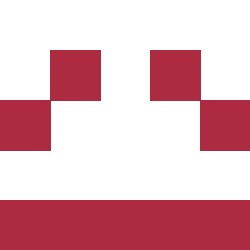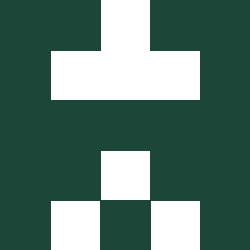Identicon generation process¶
An indenticon is a 250x250px image which is splitted into a 5x5 grid - each 50x50px. The squares are mirrored around the center axis. The identicons are not generated randomly, but based on it's input.
So the Identicon generator will accept a string as an input, from it, will generate the identicon and save it as an image into a filesystem.
The actual process of building an image¶
- We take a string
- Compute MD5 hash of the string
- List of numbers based on the string
- Pick color
- Build grid of squares
- Convert grid into image
- Save image
The process¶
We create a new project called identicon:
davis@davis-arch ~/projects/elixir mix new identicon
* creating README.md
* creating .formatter.exs
* creating .gitignore
* creating mix.exs
* creating config
* creating config/config.exs
* creating lib
* creating lib/identicon.ex
* creating test
* creating test/test_helper.exs
* creating test/identicon_test.exs
Your Mix project was created successfully.
You can use "mix" to compile it, test it, and more:
cd identicon
mix test
Run "mix help" for more commands.
Add the main method that will handle the input of the string. This main function will call all the necessary steps for the program.
Then we add a method called hash_input that handles the hashing the string and return it as a list of 16 numbers.
def hash_input(input) do
:crypto.hash(:md5, input)
|> :binary.bin_to_list
end
The numerical values will range from 0-255 in this list, so we can use the first 3 values in the list to the next step - picking the color.
So the next step is to build a grid, which needs to be 5x5 and symetrical by the center axis.
1 2 3 2 1
4 5 6 5 4
7 8 9 8 7
10 11 12 11 10
13 14 15 14 13
Then apply each number in the list to a square. Color in the squares if the number is even, leave blank squares where number is odd.
We can use struct data structure in elixir to construct this grid. These are similar to maps, but they enforce that the only properties in the struct are previously defined.
By convention, if we previously know the properties of the data structure, we use a struct instead of a map.
To define a struct, we need to make a new module, so in the we create a new file called lib/image.ex.
In the struct, the list of numbers will be called hex.
defmodule Identicon.Image do
defstruct hex: nil
end
And we can modify the hash_input to return the struct instead.
def hash_input(input) do
hex = :crypto.hash(:md5, input)
|> :binary.bin_to_list
%Identicon.Image{hex: hex}
end
Now we implement the pick_color method. It will accept the %Identicon.Image struct.
def pick_color(image) do
%Identicon.Image{ hex: [r, g, b | _tail] } = image
%Identicon.Image{ image | color: {r,g,b} }
end
We can refactor the code into a following structure:
def pick_color(%Identicon.Image{ hex: [r, g, b | _tail] } = image) do
%Identicon.Image{ image | color: {r,g,b} }
end
Now we implement the build_grid method which will chunk the input list by 3 elements and mirror the rows.
def build_grid(%Identicon.Image{hex: hex} = image) do
grid =
hex
|> Enum.chunk(3)
|> Enum.map(&mirror_row/1)
|> List.flatten
|> Enum.with_index
%Identicon.Image{ image | grid: grid }
end
def mirror_row(row) do
[first, second | _tail] = row
row ++ [second, first]
end
The &mirror_row/1 is a reference to a function mirror_row.
The next step is to filter out the odd squares.
def filter_odd_squares(%Identicon.Image{grid: grid} = image) do
grid = Enum.filtergrid, fn({code, _index}) ->
# calculate reminder by 2, if 0 - keep in list
rem(code, 2) == 0
end
%Identicon.Image{image | grid: grid}
end
Now we can implement function for creating the actual image by using the Erlang egd since elixir itself does not provide any image manipulation libraries.
To install it, we add a dependency in mix.exs
{:egd, github: "erlang/egd"}
Then restart the terminal and run the iex -S mix, it will ask for installing rebar3, accept and continue.
The first step is to create a pixel map for the for telling the Erlang egd how to draw the grid.
def build_pixel_map(%Identicon.Image{grid: grid} = image) do
Enum.map grid, fn({_code, index}) ->
horizontal = rem(index, 5) * 50
vertical = div(index, 5) * 50
top_left = {horizontal, vertical}
bottom_right = {horizontal + 50, vertical + 50}
{top_left, bottom_right}
end
end
And now, draw the image
def draw_image(%Identicon.Image{color: color, pixel_map: pixel_map}) do
image = :egd.create(250, 250)
fill = :egd.color(color)
Enum.each pixel_map, fn({start, stop}) ->
:egd.filledRectangle(image, start, stop, fill)
end
:egd.render(image)
end
Now create a method for saving into the filesystem
def save_image(image, filename) do
File.write("#{filename}.png", image)
end
And bootstrap everything in the main function
def main(input) do
input
|> hash_input
|> pick_color
|> build_grid
|> filter_odd_squares
|> build_pixel_map
|> draw_image
|> save_image(input)
end
Now, we can run the Identicon.main and get the following images:
Identicon.main("identicon")

Identicon.main("davis")
